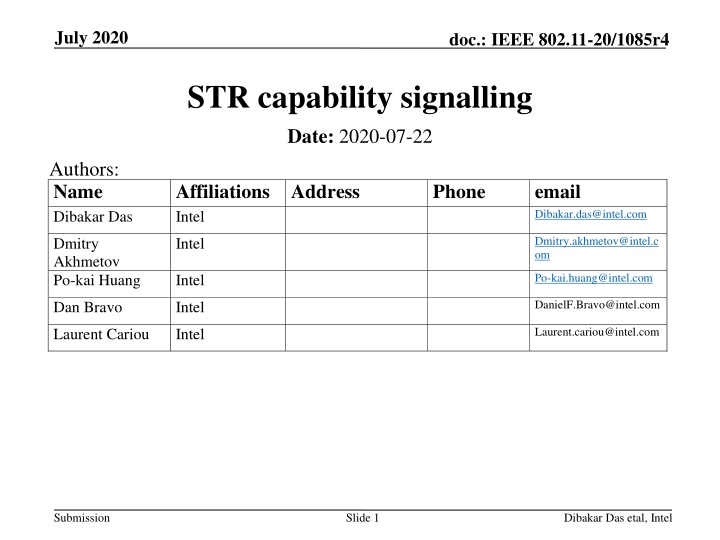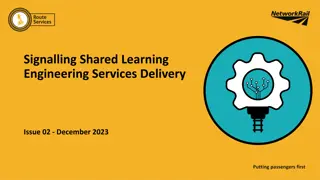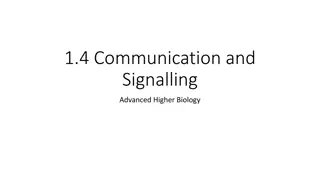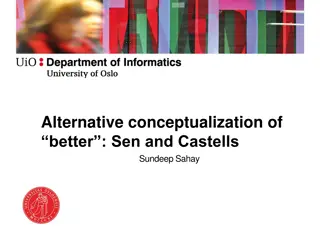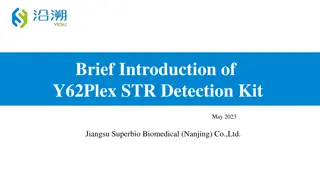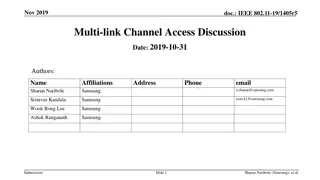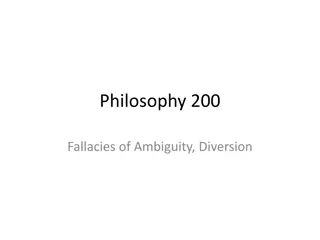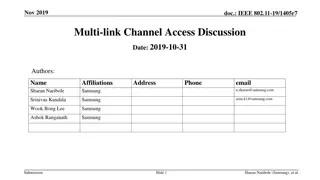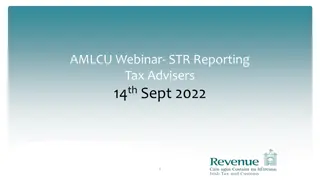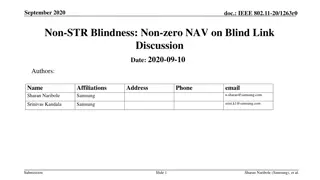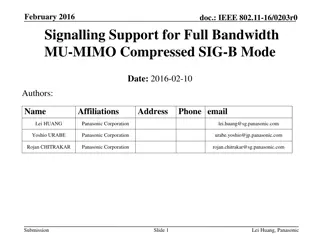IEEE 802.11-20/1085r4 STR Capability Signalling
Discusses how the STR capability can be signaled in IEEE 802.11-20/1085r4 document, focusing on multi-link channel access and capability signaling. The presentation provides detailed information on the signaling related to STR/NSTR multi-link channel access.
Uploaded on Apr 04, 2025 | 2 Views
Download Presentation

Please find below an Image/Link to download the presentation.
The content on the website is provided AS IS for your information and personal use only. It may not be sold, licensed, or shared on other websites without obtaining consent from the author.If you encounter any issues during the download, it is possible that the publisher has removed the file from their server.
You are allowed to download the files provided on this website for personal or commercial use, subject to the condition that they are used lawfully. All files are the property of their respective owners.
The content on the website is provided AS IS for your information and personal use only. It may not be sold, licensed, or shared on other websites without obtaining consent from the author.
E N D
Presentation Transcript
July 2020 doc.: IEEE 802.11-20/1085r4 STR capability signalling Date: 2020-07-22 Authors: Name Dibakar Das Affiliations Address Intel Phone email Dibakar.das@intel.com Dmitry.akhmetov@intel.c om Dmitry Akhmetov Po-kai Huang Intel Po-kai.huang@intel.com Intel DanielF.Bravo@intel.com Dan Bravo Intel Laurent.cariou@intel.com Laurent Cariou Intel Submission Slide 1 Dibakar Das etal, Intel
July 2020 doc.: IEEE 802.11-20/1085r4 Abstract Discusses how the STR capability can be signalled. Submission Slide 2 Dibakar Das etal, Intel
July 2020 doc.: IEEE 802.11-20/1085r4 Background (ML channel access) The current 11be spec contains the following text about STR/NSTR multi-link channel access: An MLD can indicate capability to support exchanging frames simultaneously by affiliated STAs on a set of links to another MLD in TBD capability field/element. The capability field/element indicates the MLD is a multi-radio MLD or other types of MLD. A multi-radio MLD operating on multiple links can announce whether it supports transmission on one link concurrent with reception on the other link for each pair of links, in which case the pair of link is STR or NSTR. The two links of each link pair are on different channels. In this presentation we provide more details on the signaling related to above text. Submission Slide 3 Dibakar Das etal, Intel
July 2020 doc.: IEEE 802.11-20/1085r4 Background (ML capability signaling) Current agreement on MLD-level information sharing: New ML element : A new element will be defined as a container to advertise and exchange capability information for multi-link setup. Common and per STA info in ML element: Do you support that an STA of an MLD can provide MLD-level information that is common to all STAs affiliated with the MLD and per-link information that is specific to the STA on each link in management frames during multi-link setup? The specific information is TBD [#SP65] Do you agree to define mechanism(s) to include MLO information that a STA of an MLD provides in its mgmt. frames, during discovery and ML setup, as described below? MLD (common) Information Information common to all the STAs of the MLD Per-link information Capabilities and Operational parameter of other STAs of the MLD other than the advertising STA [#SP91] Submission Slide 4 Dibakar Das etal, Intel
July 2020 doc.: IEEE 802.11-20/1085r4 Assumption: ML element contains signaling (explicit or implicit) about the number of STA profiles (N). For example, a single non-AP radio STA that tries to set up ML with a tri-band AP, N =3. Some pair of links are always assumed to be STR in spec (e.g., one link in 2.4 GHz band and one in 5 GHz) and hence don t need to be signaled. Submission Slide 5 Dibakar Das etal, Intel
July 2020 doc.: IEEE 802.11-20/1085r4 Proposal The common part of ML element shall contain a field signaling the number of links in which that MLD can exchange frames simultaneously (M). For example, for Single Radio MLDs, M = 1, for dual radio, M = 2 We propose that the default mechanism in 11be R1 for signaling STR/NSTR capability for a pair of links in a multi-radio MLD is through a bit-map signaling. Submission Slide 6 Dibakar Das etal, Intel
July 2020 doc.: IEEE 802.11-20/1085r4 Signaling of STR/NSTR capability Option 1: signal as an MLD-level capability information within common part of the ML element that is only present if a MR MLD. Signal # of supportable links (M) can be used simultaneously (in STR/NSTR mode). Bit-map for each pair of links ( 1=> STR pair; 0 otherwise) when M > 1. Element ID Length Element ID extension MLD common Info Informatio n about STA-1 Information about STA N # of Supportabl e links (N) # of simultaneou s links (M) STR capability bitmap Other params STR/NSTR (links 1&2) STR/NSTR (links 1&3) STR/NSTR (links 2&3) STR/Non-STR (links 1 &2) Bits: 1 Bits: 1 1 1 STR capability bitmap when N =2 and M > 1 STR capability bitmap when N =3 and M > 1 Submission Slide 7 Dibakar Das etal, Intel
July 2020 doc.: IEEE 802.11-20/1085r4 Signaling of STR capability (contd.) Option 2: signal as an MLD-level capability information the # of supportable links but STA level information for individual pairs. Element ID Length Element ID extension MLD common Info Informatio n about STA-1 Information about STA N Other params # of Supportable links (N) # of simultaneous links (M) MLD common Info Other params STR/NSTR (links 1&2) Other params STR/NSTR (links 1&2) STR/NSTR (links 1&3) Bits: x 1 Bits: x 1 1 Information about STA-1 when N =2 & M > 1 (similarly for STA-2). Information about STA-1 when N =3 & M > 1 (similarly for STA-2,3). Submission Slide 8 Dibakar Das etal, Intel
July 2020 doc.: IEEE 802.11-20/1085r4 Signaling of STR capability (contd.) Option 3: mixed mode between Option 1 & 2 where the bitmap signaling is inside STA-profile without duplication. Element ID Length Element ID extension MLD common Info Informatio n about STA-1 Information about STA N Other params SR/MR # of Supportable links (N) # of simultaneous links (M) MLD common Info Bits: x 1 2 2 N =3 & M > 1 case Other params STR/NSTR (links 1&2) STR/NSTR (links 1&3) Other params Other params STR/NSTR (links 2&3) Bits: x 1 1 x 1 x Information about STA-2. Information about STA-3. Information about STA-1. Submission Slide 9 Dibakar Das etal, Intel
July 2020 doc.: IEEE 802.11-20/1085r4 Comparison and Usage Option 2 is preferable because even though it has slightly higher overhead, the parsing is easier. At non-AP STA side, Probe Request does not contain STR Capability Info. Association Request contains STR Cap Info. Submission Slide 10 Dibakar Das etal, Intel
July 2020 doc.: IEEE 802.11-20/1085r4 EMLSR/EMLMR support The draft 0.1 spec mentions that EMLSR and EMLMR capability are at MLD-level: An MLD with dot11EHTEMLSROptionImplemented equal to true shall set the EMLSR mode subfield of the TBD Capabilities element, which is an MLD level capabilities element, to 1 An MLD with dot11EHTEMLMROptionImplemented equal to true shall set the EMLMR Support subfield of the TBD Capabilities element, which indicates MLD level capabilities, to 1.. ; We propose that since those two fields represent MLD- level information, the common part of the basic ML element shall contain them. Submission Slide 11 Dibakar Das etal, Intel
July 2020 doc.: IEEE 802.11-20/1085r4 Summary Proposed bitmap to signal pairwise STR/NSTR capability of an MLD. Signaling to be carried in the ML element during MLO Setup. Submission Slide 12 Dibakar Das etal, Intel
July 2020 doc.: IEEE 802.11-20/1085r4 SP 1 Do you agree to add the following to SFD: the common info part of the basic ML element transmitted by a non-AP MLD in a (Re)Association Request frame shall include a field that indicates the maximum number of affiliated STAs in the non-AP MLD that support simultaneous exchange of data frames (n) a field value that corresponds to n=1 indicates that the non-AP MLD is a single radio MLD a field value that corresponds to n=2 or more indicates that the non-AP MLD is a multi-radio MLD ? Submission Slide 13 Dibakar Das etal, Intel
July 2020 doc.: IEEE 802.11-20/1085r4 SP 2 Do you agree to add the following to SFD: The common part of the basic ML element transmitted by an MLD contains an EMLSR Mode subfield and an EMLMR Support subfield ? Submission Slide 14 Dibakar Das etal, Intel
July 2020 doc.: IEEE 802.11-20/1085r4 SP 3 Do you agree to add the following to SFD: an MLMR non-AP MLD that has at least one NSTR pair of links shall include in the STA profiles of a basic ML element, a bitmap where each bit represents STR/NSTR capability for a pair of links containing this STA, otherwise it shall not include the bitmap? Note: some pair of links (e.g., one link in 2.4 GHz band and another in 5 GHz band) may be specified to be always STR in spec and not included in bitmap ? Submission Slide 15 Dibakar Das etal, Intel
July 2020 doc.: IEEE 802.11-20/1085r4 Definition of constrained MLO The existing SFD text identifies simultaneous transmit/receive issue over a pair of links but not a clear definition of the constraints. In this presentation (similar to that proposed in 081r3) we assume that a pair of links at an MLD is considered non-STR if transmission by the MLD in one link impairs its Receiver minimum input level sensitivity or CCA sensitivity on the other link; otherwise that pair is considered STR . The transmission may be assumed at max transmit power capability. Note that this definition still allows potential STR operation by a non-STR pair of links depending on RSSI, MCS level etc. For example, Rx at MCS-4 may be possible but not Rx at MCS-13 during Tx on the other link. Note: the signaling in this presentation is largely independent of this definition. Submission Slide 16 Dibakar Das etal, Intel
July 2020 doc.: IEEE 802.11-20/1085r4 Proposal (Contd.) STR capability related submissions: Submission 0921r0 proposes an option to signal STR capability + cross-link interference estimate. Submission 0809r0 also proposes that a STA signals its leakage estimates to AP. Submission 1550r1 lists bit-wise signaling of pairwise STR capability as an option. We believe that the default mechanism for R1 signaling STR/NSTR capability to be the bit-map signaling. Submission Slide 17 Dibakar Das etal, Intel
July 2020 doc.: IEEE 802.11-20/1085r4 20/0226r5 (MLO Constraint Indication and Operating Mode, Sharan Naribole, Samsung) Do you support the addition of the following text to TGbe SFD? A non-AP MLD may update its ability to perform simultaneous transmission and reception on a pair of setup links after multi-link setup. This update for any pair of setup links can be announced by non-AP MLD on any enabled link. NOTE Specific signaling for update indication is TBD NOTE - Limitations on dynamic updating is TBD Y/N/A/No answer: 43/7/29/19 Submission Slide 18 Dibakar Das etal, Intel
